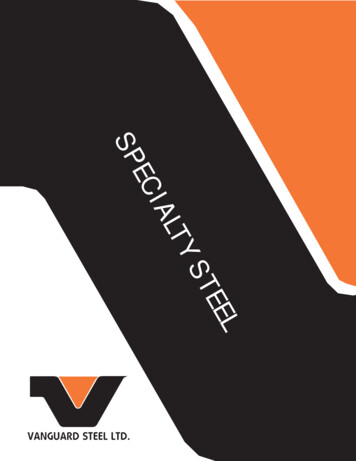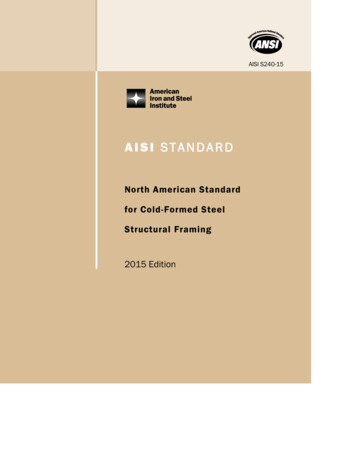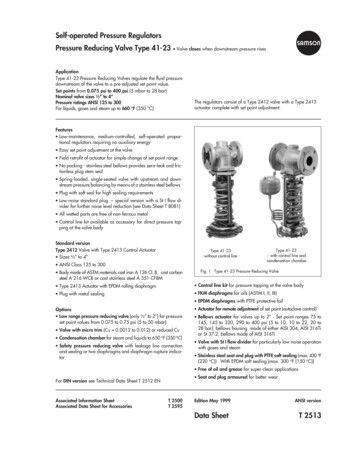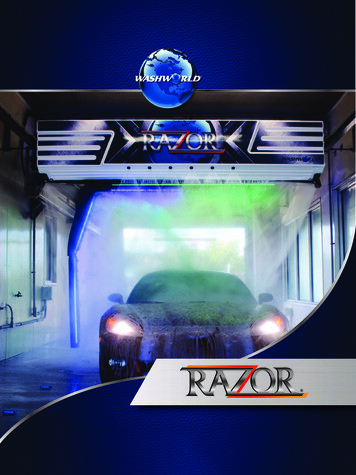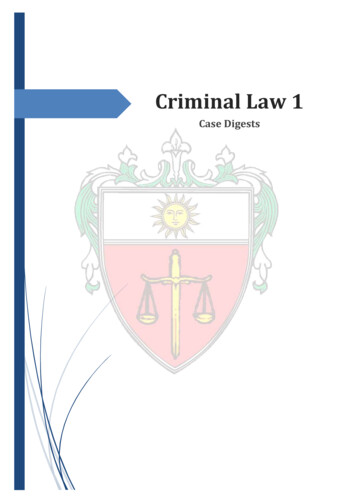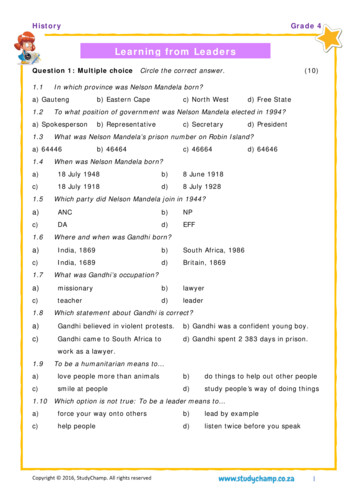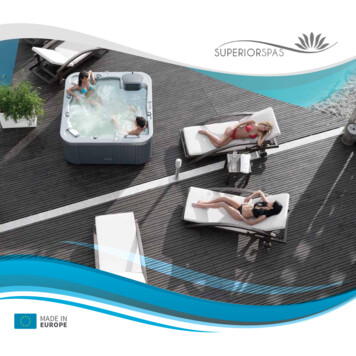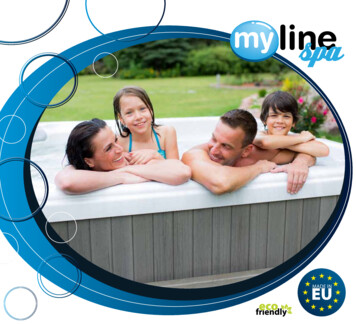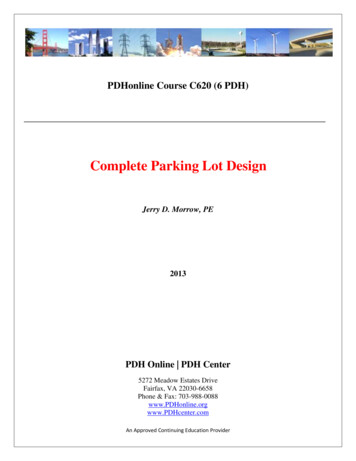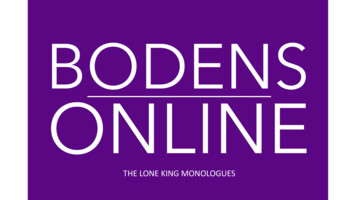
Transcription
AISI S100-16w/S1-18AISI STANDARDNorth American Specificationfor the Design of Cold-FormedSteel Structural Members2016 Edition with Supplement 1Approved in Canada by CSA GroupEndorsed in Mexico by CANACERO
AISI S100-16w/S1-18AISI STANDARDNorth American Specificationfor the Design of Cold-FormedSteel Structural Members2016 EDITION WITH SUPPLEMENT 1Approved in Canada by CSA GroupEndorsed in Mexico by CANACERO
iiAISI S100-16w/S1-18DISCLAIMERThe material contained herein has been developed by a joint effort of the American Iron andSteel Institute (AISI) Committee on Specifications, CSA Group Technical Committee on ColdFormed Steel Structural Members (S136), and Camara Nacional de la Industria del Hierro y delAcero (CANACERO) in Mexico. The organizations and the Committees have made a diligenteffort to present accurate, reliable, and useful information on cold-formed steel design. TheCommittees acknowledge and are grateful for the contributions of the numerous researchers,engineers, and others who have contributed to the body of knowledge on the subject. Specificreferences are included in the Commentary on the Specification.With anticipated improvements in understanding of the behavior of cold-formed steel andthe continuing development of new technology, this material may eventually become dated. Itis anticipated that future editions of this Specification will update this material as newinformation becomes available, but this cannot be guaranteed.The materials set forth herein are for general information only. They are not a substitute forcompetent professional advice. Application of this information to a specific project should bereviewed by a registered professional engineer. Indeed, in most jurisdictions, such review isrequired by law. Anyone making use of the information set forth herein does so at their ownrisk and assumes any and all resulting liability arising therefrom.1st Printing – October 20162nd Printing – March 2018rd3 Printing – December 2018Produced by American Iron and Steel InstituteCopyright American Iron and Steel Institute and CSA Group 2016
North American Specification for the Design of Cold-Formed Steel Structural Members, 2016 Edition WithSupplement 1iiiDEDICATIONThis edition of AISI S100 is dedicated to Roger L. Brockenbrough, P.E., who served aschairman of the AISI Committee on Specifications from 1991 to 2016. Roger led thedevelopment of the first unified ASD and LRFD steel design specification, as well as the firstharmonized North American Cold-Formed Steel Specification. The Direct Strength Method wasintroduced under his leadership, and is incorporated into the main body of this edition of AISIS100. The Committee recognizes his significant contributions to the development of AISI S100,AISI S310, AISI test standards, and AISI design guides and manuals. The members of the AISICommittee on Specifications have valued Roger’s open-minded leadership approach and hiswillingness to promote new ideas and suggestions. Roger has been instrumental in thesuccesses of the Committee on Specifications. The staff and members of AISI, along with themembers of the Committee, greatly appreciate his dedication and contributions towardadvancing the cold-formed steel industry.
ivAISI S100-16w/S1-18This Page is Intentionally Left Blank.
North American Specification for the Design of Cold-Formed Steel Structural Members, 2016 Edition WithSupplement 1vPREFACEThe North American Specification for the Design of Cold-Formed Steel Structural Members, as itsname implies, is intended for use throughout Canada, Mexico, and the United States. ThisSpecification supersedes the 2012 and previous editions of the North American Cold-Formed SteelSpecification, the previous editions of the Specification for the Design of Cold-Formed Steel StructuralMembers published by the American Iron and Steel Institute (AISI), and the previous editions ofCSA Group S136, Cold Formed Steel Structural Members, published by CSA Group.The Specification was developed by a joint effort of the American Iron and Steel InstituteCommittee on Specifications, CSA Group Technical Committee on Cold Formed Steel StructuralMembers (S136), and Camara Nacional de la Industria del Hierro y del Acero (CANACERO) inMexico. This effort was coordinated through the North American Specification Committee,which was made up of members from the AISI Committee on Specifications and the CSA GroupS136 Committee.Since the Specification is intended for use in Canada, Mexico, and the United States, it wasnecessary to develop a format that would allow for requirements particular to each country.This resulted in a main document, Chapters A through M and Appendices 1 and 2, that isintended for use in all three countries, and two country-specific appendices (A and B).Appendix A is for use in both the United States and Mexico, and Appendix B is for use inCanada. A symbol ( A,B ) is used in the main document to point out that additional provisionsare provided in the corresponding appendices indicated by the letters.This Specification provides an integrated treatment of Allowable Strength Design (ASD), Loadand Resistance Factor Design (LRFD), and Limit States Design (LSD). This is accomplished byincluding the appropriate resistance factors (f) for use with LRFD and LSD and the appropriatesafety factors (Ω) for use with ASD. It should be noted that the use of LSD is limited to Canadaand the use of ASD and LRFD is limited to the United States and Mexico.The Specification also contains some terminology that is defined differently in Canada, theUnited States, and Mexico. These differences are set out in Section A1.3, “Definitions.” In theSpecification, the terms that are specifically applicable to LSD are included in square brackets.The Specification provides well-defined procedures for the design of load-carrying cold-formedsteel members in buildings, as well as other applications, provided that proper allowances aremade for dynamic effects. The provisions reflect the results of continuing research to developnew and improved information on the structural behavior of cold-formed steel members. Thesuccess of these efforts is evident in the wide acceptance of the previous editions of theSpecification.The AISI and CSA Group consensus committees responsible for developing these provisionsprovide a balanced forum, with representatives of steel producers, fabricators, users, educators,researchers, and building code regulators. They are composed of engineers with a wide range ofexperience and high professional standing from throughout Canada and the United States.AISI, CSA Group, and CANACERO acknowledge the continuing dedication of the members ofthe specifications committees and their subcommittees. The membership of these committeesfollows this Preface.The 2016 Edition of the Specification has been reorganized by incorporating the DirectStrength Method design provisions into Chapters A through M. Also, the chapters are laid out tobe more in line with ANSI/AISC 360-2010. A section reference table of the 2012 Edition of the
viPrefaceSpecification and this edition is provided.In addition to content reorganization, the following changes and additions are made in thisedition:Section A2, Referenced Specifications, Codes and Standards. All the references, includingthose specific to U.S. and Mexico or Canada, are listed in the main body of theSpecification. All the referenced standards are updated.Section A3.2, Other Steels. The country-specific provisions are consolidated by bringing theprovisions into the main body of the Specification.Section B2, Loads and Load Combinations. The applicable building codes for determining theloads and load combinations are introduced for the U.S., Mexico, and Canada.Section B3, Design Basis. This section introduces three design methods: ASD and LRFD areapplicable to the U.S. and Mexico, and LSD is applicable to Canada. It referencesSpecification chapters or sections that provide design provisions for required strength [effectdue to factored loads] and available strengths [factored resistances], structural members,connections, stability, structural assemblies and systems, serviceability, ponding, fatigue,and corrosion effects.Section B4, Dimensional Limits and Considerations. The limitations for applying the EffectiveWidth Method and the Direct Strength Method are streamlined.Section C1, Design for System Stability. The provisions consider Appendix 2, Second-OrderAnalysis, included in the 2012 Edition of the Specification, and incorporate system stabilityanalysis approaches provided in ANSI/AISC 360.Chapters E, F and G. The provisions of the Direct Strength Method included in Appendix 1 ofthe 2012 Edition of the Specification are incorporated into these chapters.Section F2.1.1, Singly- or Doubly-Symmetric Sections Bending About Symmetric Axis.Simplified Equation F2.1.1-6 to determine elastic buckling stress, Fcre, is no longerapplicable to singly-symmetric C-Sections.Section H1, Combined Axial Load and Bending. The interaction check equations for ASD,LRFD, and LSD are combined into one format, as applicable.Section H1.2, Combined Compressive Axial Load and Bending. The interaction checkequations are revised with the moment magnification effect taken into considerationthrough the system stability effect in accordance with Section C1.Section I2, Floor, Roof, or Wall Steel Diaphragm Construction. AISI S310, AISI S240, and AISIS400 are introduced for diaphragm design, and the table of Safety and Resistance Factorsfor Diaphragms is moved to AISI S310.Section I4, Cold-Formed Steel Light-Frame Construction. The cold-formed steel framingstandards are updated.Section I5, Special Bolted Moment Frame Systems. Special bolted moment frame systemsshould be designed in accordance with AISI S400.Section I6.1, Members Strength: General Cross-Sections and System Connectivity. Thissection permits the bending and compression strengths of purlins and girts to bedetermined analytically provided the lateral, rotational, and composite stiffness providedby the deck or sheathing, bridging and bracing, and span continuity are included.Section I7, Rack Systems. Rack system design should be in accordance with ANSI MH16.1.Section J2, Welded Connections. The country-specific standards are brought into the main
North American Specification for the Design of Cold-Formed Steel Structural Members, 2016 Edition WithSupplement 1viibody of the Specification.Section J3, Bolted Connections. The table of Nominal Tensile and Shear Strengths for Bolts inAppendix A has been updated to be consistent with those in ANSI/AISC 360, and valuesfor bolt diameters less than 0.5 in. (12 mm) have been revised.Section J7.2, Power-Actuated Fasteners (PAFs) in Concrete. The PAF pull-out strength inshear in cold-formed steel framing track-to-concrete connections is added.Section K1, Test Standards. The AISI S900 series of test standards are introduced, and thestandards are also referenced in Section A2.Section K2, Test for Special Cases. The sentence that the provisions shall not apply to coldformed steel diaphragms was deleted.Section K2.1.1, Load and Resistance Factor Design and Limit States Design. The table ofStatistical Data for the Determination of Resistance Factor is simplified. The sentence thatSection K2.1.1(b) is not applicable to floor, roof or wall steel diaphragm was deleted.Appendix 1, Effective Width of Elements. This appendix provides provisions for determiningthe effective width of elements as needed for the Effective Width Method.Appendix 2, Elastic Buckling Analysis of Members. This new appendix provides analyticaland numerical approaches to determine the local, distortional, and global bucklingstrengths.In the 2nd printing, Errata 1, published on March 20, 2018, has been incorporated.In the 3rd printing, Supplement 1 to the 2016 Edition of the North American Specificationhas been incorporated. The following changes are included in Supplement 1:Section A3.3.2, Strength Increase From Cold Work of Forming. Revisions are made to the firstparagraph to remove the requirement of no distortional buckling for considering strengthincrease from cold work of forming.Section E2.2, Doubly- or Singly-Symmetric Sections Subject to Torsional or Flexural-TorsionalBuckling. The last paragraph is revised so that the provisions can be applicable formembers with holes.Section H1.2, Combined Compression Axial Load and Bending. The second paragraph isrevised so that the provisions can be applicable for members with holes.Section J7.2, Power-Actuated Fasteners (PAFs) in Concrete. This section is removed to avoidunconservative designs of track and other cold-formed steel structural memberattachments to concrete and to avoid unintended interpretation of the validity of theseprovisions in different applications.American Iron and Steel InstituteCSA GroupCamara Nacional de la Industria del Hierro y del Acero
viiiPrefaceThis Page is Intentionally Left Blank.
North American Specification for the Design of Cold-Formed Steel Structural Members, 2016 Edition WithSupplement 1ixNorth American Specification CommitteeAISIR. L. BrockenbroughH. H. ChenCSA GroupR. M. Schuster, ChairmanS. R. Fox, SecretaryAISI Committee on Specifications for the Designof Cold-Formed Steel Structural Members and Its SubcommitteesR. L. Brockenbrough, ChairmanP. BodwellL. R. DaudetS. R. FoxW. B. HallR. L. MadsenN. A. RahmanA. SarawitT. SputoR. B. Haws, Vice-ChairmanJ. BuckholtR. S. DouglasD. FultonG. J. HancockJ. A. MattinglyG. RalphB. W. SchaferR. ZiemianH. H. Chen, SecretaryC. J. CarterW. S. EasterlingR. S. GlauzA. J. HarroldW. McRoyV. E. SaganK. SchroederD. AllenJ. K. CrewsJ. M. FisherP. S. GreenR. A. LaBoubeJ. R. U. MujagicT. SamiappanR. M. SchusterEmeritus MembershipD. S. EllifrittT. B. PekozD. L. JohnsonT. W. J. TrestainT. M. MurrayW. W. YuJ. N. NunneryL. R. DaudetB. GerberA. J. HarroldC. MoenJ. N. NunneryT. SamiappanT. SputoW. S. EasterlingW. GouldD. L. JohnsonJ. R. U. MujagicN. A. RahmanK. SchroederS. TorabianW. S. EasterlingW. B. HallJ. A. MattinglyN. A. RahmanK. SchroederK. VoigtD. FoxJ. M. KlaimanC. MoenG. RalphW. E. SchultzD. FoxP. S. GreenT. M. MurrayN. A. RahmanR. M. SchusterS. R. FoxW. B. HallJ. D. MusselwhiteG. RalphF. SesmaSubcommittee 3 – Connections and JointsP. S. Green, ChairmanL. ChenD. FoxD. FultonW. B. HallG. J. HancockJ. A. MattinglyA. MerchantT. M. MurrayJ. D. MusselwhiteG. RalphV. E. SaganR. M. SchusterF. SesmaC. YuSubcommittee 4 – Assemblies and SystemsT. Sputo, ChairmanL. R. DaudetB. GerberW. GouldR. L. MadsenJ. R. MartinR. V. NunnaJ. NunneryV. E. SaganB. W. SchaferR. M. SchusterM. SeekSubcommittee 6 – Test-Based DesignL. R. Daudet, ChairmanJ. DesLaurierB. GerberW. GouldJ. R. MartinC. MoenR. V. NunnaJ. N. NunneryT. SamiappanB. W. SchaferT. Sputo
xCommittee RostersSubcommittee 22 – Stability and Combined ActionsJ. K. Crews, ChairmanL. R. DaudetP. S. GreenG. J. HancockZ. LiR. L. MadsenJ. N. NunneryT. B. PeközT. SamiappanA. SarawitW. E. SchultzS. TorabianC. YuR. ZiemianD. FultonA. J. HarroldC. MoenG. RalphB. W. SchaferH. YektaiR. S. GlauzD. L. JohnsonJ. R. U. MujagicV. E. SaganK. SchroederL. XuSubcommittee 24 – Member DesignA. J. Harrold, ChairmanD AllenL. R. DaudetJ. M. FisherP. S. GreenG. J. HancockJ. A. MattinglyC. MoenJ. J. PoteG. RalphK. SchroederW. E. SchultzD. D. ToblerC. YuJ. BuckholtD. FultonD. L. JohnsonJ. N. NunneryT. SamiappanR. M. SchusterR. ZiemianJ. K. CrewsR. S. GlauzR. L. MadsenT. B. PeközB. W. SchaferT. SputoSubcommittee 31 – General ProvisionsJ. M. Fisher, ChairmanD. AllenL. R. DaudetR. S. DouglasJ. M. KlaimanR. L. MadsenG. RalphB. W. SchaferC. J. CarterW. B. HallC. MoenR. M. SchusterJ. K. CrewsA. J. HarroldJ. N. NunneryCSA Group Technical Committee on Cold Formed Steel Structural MembersR. M. Schuster, ChairmanJ. J. R. ChengB. MandelzysK. S. SivakumaranL. XuS. R. Fox, Vice ChairmanD. G. DelaneyS. S. McCavourM. SommersteinA. AhmadD. FoxM. MirM. TancrediD. BakJ. B. GraceC. RogersP. Versavel
North American Specification for the Design of Cold-Formed Steel Structural Members, 2016 Edition WithSupplement 1PersonnelA. AhmadD. AllenD. BakP. BodwellR. L. BrockenbroughJ. BuckholtC. J. CarterH. H. ChenL. ChenJ.J. R. ChengJ. K. CrewsL. R. DaudetD. G. DelaneyJ. DesLaurierR. S. DouglasW. S. EasterlingJ. M. FisherD. FoxS. R. FoxD. FultonB. GerberR. S. GlauzW. GouldJ. B. GraceP. S. GreenW. B. HallG. J. HancockA. J. HarroldJ. M. KlaimanR. A. LaBoubeZ. LiR. L. MadsenB. MandelzysJ. R. MartinJ. A. MattinglyS. S. McCavourW. McRoyA. MerchantM. MirC. MoenJ. R. U. MujagicT. M. MurrayJ. D. MusselwhiteR. V. NunnaJ. N. NunneryT. B. PekozBailey Metal Products Ltd.Super Stud Building ProductsSteelway Building SystemsVerco Decking Inc.R. L. Brockenbrough and AssociatesComputerized Structural DesignAmerican Institute of Steel ConstructionAmerican Iron and Steel InstituteBaltimore Aircoil CompanyUniversity of AlbertaUnarco Material Handling, Inc.Simpson Strong-TieFlynn Canada Ltd.Certified Steel Stud AssociationNational Council of Structural Engineers AssociationsVirginia Polytechnic Institute and State UniversityConsultantTOTAL JOIST By iSPAN SystemsCanadian Sheet Steel Building InstituteTriangle Fastener CorporationIAPMO Uniform Evaluation ServiceRSG Software, Inc.ICC Evaluation Service, Inc.Robertson Building SystemsBechtel Power CorporationUniversity of IllinoisUniversity of SydneyBlueScope Buildings North AmericaADTEK EngineersWei-Wen Yu Center for Cold-Formed Steel StructuresSUNY Polytechnic InstituteSupreme Steel Framing System AssociationSteelriteVerco Decking, Inc.ConsultantIRC Building Sciences GroupICC Evaluation Service, Inc.KeymarkVicwestVirginia Polytechnic Institute and State UniversityConsultantConsultantSouthern Code Consulting International, LLCS. B. Barnes AssociatesConsultantConsultantxi
xiiPersonnelJ. J. PoteN. A. RahmanG. RalphC. RogersV. E. SaganT. SamiappanA. SarawitB. W. SchaferK. SchroederW. E. SchultzR. M. SchusterM. SeekF. SesmaK. S. SivakumaranM. SommersteinT. SputoM. TancrediD. D. ToblerS. TorabianT. W. J. TrestainP. VersavelK. VoigtL. XuH. YektaiC. YuR. ZiemianNew Millennium Building Systems, LLCThe Steel Network, Inc.ClarkDietrich Building SystemsMcGill UniversityMetal Building Manufacturers AssociationOMG, Inc.Simpson Gumpetz & HegerJohns Hopkins UniversityDevco Engineering Inc.Nucor VulcraftConsultantOld Dominion UniversityCalifornia Expanded Metal ProductsMcMaster UniversityM&H EngineeringSteel Deck InstituteFerroeng Group Inc.American Buildings CompanyCold-Formed Steel Research ConsortiumConsultantBehlen Industries LPNew Millennium Building Systems, LLCUniversity of WaterlooPaco Steel EngineeringUniversity of North TexasStructural Stability Research Council
North American Specification for the Design of Cold-Formed Steel Structural Members, 2016 Edition WithSupplement 1xiiiSection Numbering Comparison — AISI S100-12 Versus AISI S100-16AISI .2A6A6.1A6.1.1A6.1.2A7A7.1A7.2A8A9Section TitleGENERAL PROVISIONSScope, Applicability, and DefinitionsScopeApplicabilityDefinitionsUnits of Symbols and TermsMaterialApplicable SteelsSteels With a Specified Minimum Elongation of Ten Percent or Greater(Elongation 10%)Steels With a Specified Minimum Elongation From Three Percent to LessThan Ten Percent (3% Elongation 10%)Steels With a Specified Minimum Elongation of Less Than Three Percent(Elongation 3%)Other SteelsPermitted Uses and Restrictions of Applicable SteelsSteels With a Specified Minimum Elongation of Ten Percent or Greater(Elongation 10%)Steels With a Specified Minimum Elongation From Three Percent to LessThan Ten Percent (3% Elongation 10%)Steels With a Specified Minimum Elongation Less than Three Percent(Elongation 3%)Steel Deck as Tensile Reinforcement for Composite Deck-SlabsDuctility Requirements of Other SteelsDuctility Requirements of Other SteelsDelivered Minimum ThicknessLoadsAllowable Strength DesignDesign BasisASD RequirementsLoad Combinations for ASDLoad and Resistance Factor DesignDesign BasisLRFD RequirementsLoad Factors and Load Combinations for LRFDLimit States DesignDesign BasisLSD RequirementsLoad Factors and Load Combinations for LSDYield Stress and Strength Increase From Cold Work of FormingYield StressStrength Increase From Cold Work of FormingServiceabilityReferenced DocumentsAISI B3.2.3B3B3.2.3B2A3.3A3.3.1A3.3.2B3.7A2
xivSection Numbering Comparison — AISI S100-12 Versus AISI S100-16Section Numbering Comparison — AISI S100-12 Versus AISI S100-16AISI n TitleELEMENTSDimensional Limits and ConsiderationsFlange Flat-Width-to-Thickness ConsiderationsMaximum Flat-Width-to-Thickness RatioFlange CurlingShear Lag EffectMaximum Web Depth-to-Thickness RatiosCorner Radius-to-Thickness RatiosEffective Widths of Stiffened ElementsUniformly Compressed Stiffened ElementsUniformly Compressed Stiffened Elements With Circular or NoncircularHolesWebs and Other Stiffened Elements Under Stress GradientC-Section Webs With Holes Under Stress GradientUniformly Compressed Elements Restrained by Intermittent ConnectionsEffective Widths of Unstiffened ElementsUniformly Compressed Unstiffened ElementsUnstiffened Elements and Edge Stiffeners With Stress GradientEffective Width of Uniformly Compressed Elements With a Simple Lip EdgeStiffenerEffective Widths of Stiffened Elements With Single or Multiple IntermediateStiffeners or Edge-Stiffened Elements With Intermediate Stiffener(s)Effective Widths of Uniformly Compressed Stiffened Elements With Single orMultiple Intermediate StiffenersSpecific Case: Single or n Identical Stiffeners, Equally SpacedGeneral Case: Arbitrary Stiffener Size, Location, and NumberEdge-Stiffened Elements With Intermediate Stiffener(s)MEMBERSProperties of SectionsTension MembersYielding of Gross SectionRupture of Net SectionFlexural MembersBendingNominal Section Strength [Resistance]Lateral-Torsional Buckling Strength [Resistance]Lateral-Torsional Buckling Strength [Resistance] of Open Cross-SectionMembersLateral-Torsional Buckling Strength [Resistance] of Closed-Box MembersFlexural Strength [Resistance] of Closed Cylindrical Tubular MembersDistortional Buckling Strength [Resistance]ShearShear Strength [Resistance] of Webs Without HolesShear Strength [Resistance] of C-Section Webs With HolesCombined Bending and ShearAISI S100-16SectionNumbersAppendix 1.41.21.2.11.2.21.31.41.4.11.4.1.11.4.1.21.4.2D, E, F, G, HB5DD2D3FF1F3.1, F2.4.1F2, F3F2.1, F2.1.1,F2.1.2, F2.1.3,F3F2.1, F2.1.4F2.3F4, F4.1GG2G3H2
North American Specification for the Design of Cold-Formed Steel Structural Members, 2016 Edition WithSupplement 1xvSection Numbering Comparison — AISI S100-12 Versus AISI S100-16AISI 3.2.1D3.3D4D4.1Section TitleASD MethodLRFD and LSD MethodsWeb CripplingWeb Crippling Strength [Resistance] of Webs Without HolesWeb Crippling Strength [Resistance] of C-Section Webs With HolesCombined Bending and Web CripplingASD MethodLRFD and LSD MethodsCombined Bending and Torsional LoadingStiffenersBearing StiffenersBearing Stiffeners in C-Section Flexural MembersShear StiffenersNonconforming StiffenersConcentrically Loaded Compression MembersNominal Strength for Yielding, Flexural, Flexural-Torsional, and TorsionalBucklingSections Not Subject to Torsional or Flexural-Torsional BucklingDoubly- or Singly-Symmetric Sections Subject to Torsional or FlexuralTorsional BucklingPoint-Symmetric SectionsNon-symmetric SectionsClosed Cylindrical Tubular SectionsDistortional Buckling Strength [Resistance]Combined Axial Load and BendingCombined Tensile Axial Load and BendingASD MethodLRFD and LSD MethodsCombined Compressive Axial Load and BendingASD MethodLRFD and LSD MethodsSTRUCTURAL ASSEMBLIES AND SYSTEMSBuilt-Up SectionsFlexural Members Composed of Two Back-to-Back C-SectionsCompression Members Composed of Two Sections in ContactSpacing of Connections in Cover-Plated SectionsMixed SystemsLateral and Stability BracingSymmetrical Beams and ColumnsC-Section and Z-Section BeamsNeither Flange Connected to Sheathing That Contributes to the Strength andStability of the C- or Z- SectionBracing of Axially Loaded Compression MembersCold-Formed Steel Light-Frame ConstructionAll-Steel Design of Wall Stud AssembliesAISI S100-16SectionNumbersH2H2G5G5G6H3H3H3H4F5, G4F5.1F5.2G4.1F5.3, .1
xviSection Numbering Comparison — AISI S100-12 Versus AISI S100-16Section Numbering Comparison — AISI S100-12 Versus AISI S100-16AISI 2.7E3E3.1E3.2E3.3Section TitleFloor, Roof, or Wall Steel Diaphragm ConstructionMetal Roof and Wall SystemsPurlins, Girts and Other MembersFlexural Members Having One Flange Through-Fastened to Deck orSheathingFlexural Members Having One Flange Fastened to a Standing Seam RoofSystemCompression Members Having One Flange Through-Fastened to Deck orSheathingCompression of Z-Section Members Having One Flange Fastened to aStanding Seam RoofStanding Seam Roof Panel SystemsStrength [Resistance] of Standing Seam Roof Panel SystemsRoof System Bracing and AnchorageAnchorage of Bracing for Purlin Roof Systems Under Gravity Load With TopFlange Connected to Metal SheathingAlternative Lateral and Stability Bracing for Purlin Roof SystemsCONNECTIONS AND JOINTSGeneral ProvisionsWelded ConnectionsGroove Welds in Butt JointsArc Spot WeldsMinimum Edge and End DistanceShearShear Strength [Resistance] for Sheet(s) Welded to a Thicker SupportingMemberShear Strength [Resistance] for Sheet-to-Sheet ConnectionsTensionCombined Shear and Tension on an Arc Spot WeldASD MethodLRFD and LSD MethodsArc Seam WeldsMinimum Edge and End DistanceShearShear Strength [Resistance] for Sheet(s) Welded to a Thicker SupportingMemberShear Strength [Resistance] for Sheet-to-Sheet ConnectionsTop Arc Seam Sidelap WeldsShear Strength [Resistance] of Top Arc Seam Sidelap WeldsFillet WeldsFlare Groove WeldsResistance WeldsBolted ConnectionsMinimum SpacingMinimum Edge and End DistancesBearingAISI J3.1J3.2J3.3
North American Specification for the Design of Cold-Formed Steel Structural Members, 2016 Edition WithSupplement 1xviiSection Numbering Comparison — AISI S100-12 Versus AISI S100-16AISI ection TitleBearing Strength [Resistance] Without Consideration of Bolt HoleDeformationBearing Strength [Resistance] With Consideration of Bolt Hole DeformationShear and Tension in BoltsScrew ConnectionsMinimum SpacingMinimum Edge and End DistancesShearShear Strength [Resistance] Limited by Tilting and BearingShear in ScrewsTensionPull-Out Strength [Resistance]Pull-Over Strength [Resistance]Tension in ScrewsCombined Shear and TensionCombined Shear and Pull-OverASD MethodLRFD and LSD MethodsCombined Shear and Pull-OutASD MethodLRFD and LSD MethodsCombined Shear and Tension in ScrewsASD MethodLRFD and LSD MethodsPower-Actuated FastenersMinimum Spacing, Edge and End DistancesPower-Actuated Fasteners in TensionTension Strength [Resistance]Pull-Out Strength [Resistance]Pull-Over Strength [Resistance]Power-Actuated Fasteners in ShearShear Strength [Resistance]Bearing and Tilting Strength [Resistance]Pull-Out Strength [Resistance] in ShearNet Section Rupture Strength [Resistance]Shear Strength [Resistance] Limited by Edge DistanceCombined Shear and TensionRuptureShear RuptureTension RuptureBlock Shear RuptureConnections to Other MaterialsBearingTensionShearAISI 5.3.5J5.4J6J6.1J6.2J6.3J7J7.1.1J7.1.2J7.1.3
xviiiSection Numbering Comparison — AISI S100-12 Versus AISI S100-16Section Numbering Comparison — AISI S100-12 Versus AISI S100-16AISI .G1G2G3G4G5APPENDIX 1.2.11.2.2.1.2.1.11.2.2.1.2.1.2Section TitleTESTS FOR SPECIAL CASESTests for Determining Structural PerformanceLoad and Resistance Factor Design and Limit States DesignAllowable Strength DesignTests for Confirming Structural PerformanceTests for Determining Mechanical PropertiesFull SectionFlat Elements of Formed SectionsVirgin SteelDESIGN OF COLD-FORMED STEEL STRUCTURAL MEMBERS ANDCONNECTIONS FOR CYCLIC LOADING (FATIGUE)GeneralCalculation of Maximum Stresses and Stress RangesDesign Stress RangeBolts and Threaded PartsSpecial Fabrication Requirements
The North American Specification for the Design of Cold-Formed Steel Structural Members as its , name implies, is intended for use throughout Canada, Mexico, and the United States. This Specification supersedes the 2012 and previous editions of the North American Cold-Formed Steel Specification, the previous editions of the Specification for the Design
